Freeborn EAW – more time!
January 23rd, 2020
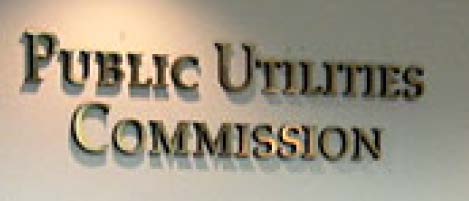
The PUC has asked for additional time, noting that our Petition for EAW for the Freeborn Wind project is expected to come before the Commission on February 6, 2020. PUC asked and PUC received:
Old news on Legalectric:
EQB forwards EAW Petition to PUC
January 3rd, 2020
Petition for EAW – Freeborn Wind
January 2nd, 2020
Commerce “response” to AFCL’s data request
January 14th, 2020

Just in, Commerce-EERA responses to Association of Freeborn County Landowners’ 11/25/2019 Data Practices Act Request:
This was the one we sent trying to get information on a Pre-Construction meeting that we’d not heard anything about, and damned if the meeting didn’t start about half an hour after we sent this request!!! Here’s the response to that 11/25/2019 request:
Some highlights:

Yes, there is that statement again of that “quick, delete those emails” Commerce policy, stated above: “As your request was received on November 25, 2019, unless I have saved an email, emails that I could provide you with would be from August 27, 2019 to November 25, 2019. ” And six times in that missive, “EERA must reiterate that email correspondence prior to August 27, 2019 had been automatically deleted by the Agency’s email system.” Yeah, we get it…
OK, fine, we send Data Practices Act Request every 90 days… we can do that.
And when we request notice of Pre-Construction meetings, after all, after all, we’re a party, have been for years now, yet from PUC’s Kaluzniak’s email about our April 23, 2019 Data Practices Request there’s an inference drawn about AFCL attendance at meetings…

And EERA says about notice to meetings:
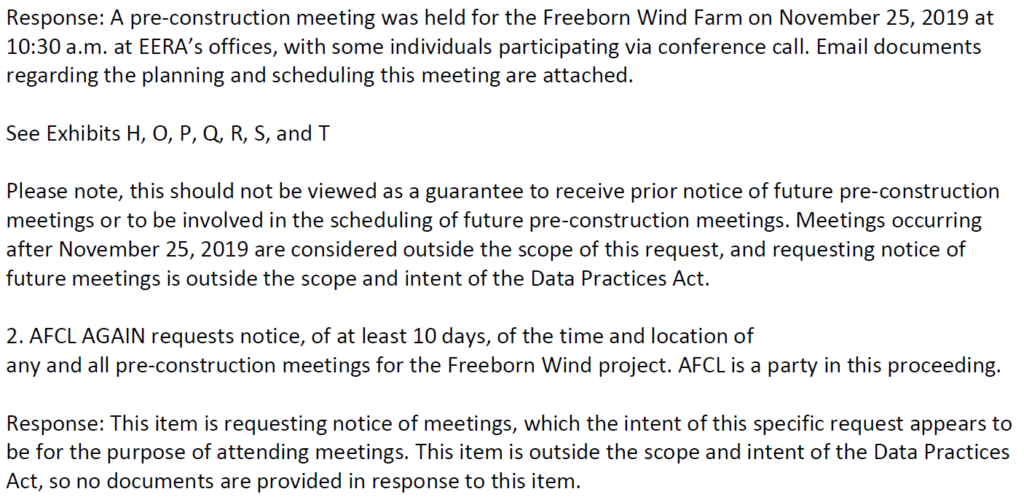
FYI – Here’s Xcel’s Summary of the 11/25/2019 Pre-Construction meeting that no one told us about, filed December 6, 2019:
That same day, just before that Xcel filing and almost 2 weeks after getting confirmation of our 11-25-2019 Data Practices Request from the Data gurus at both PUC and Commerce, this arrives from Rich Davis… can you spell “oppositional” anyone?

Yeah, it’s just more of the “Davis Shuffle.” Save, document, wait… we’re already sitting at the Court of Appeals, and we’re waiting for PUC to address our EAW Petition. Just keep it up…
PUBLIC PARTICIPATION ANYONE?
Minn. Stat. 216E.08
Subd. 2. Other public participation.The commission shall adopt broad spectrum citizen participationas a principal of operation. The form of public participation shall not be limited to public hearings andadvisory task forces and shall be consistent with the commission’s rules and guidelines as provided for insection 216E.16.
EQB forwards EAW Petition to PUC
January 3rd, 2020
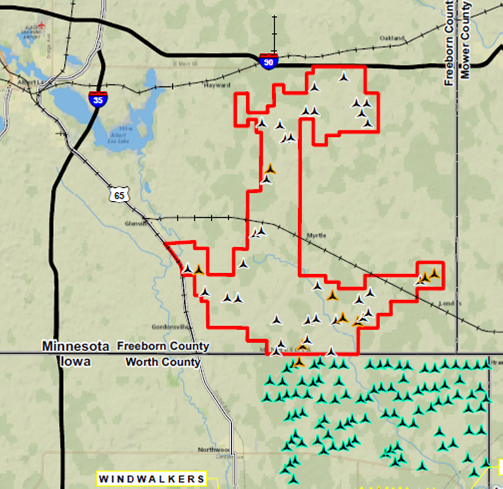
The Environmental Quality Board has forwarded Association of Freeborn Landowners’ Petition for Environmental Assessment Worksheet to the Public Utilities Commission. YES!
They zipped it, listed as “FreebornWind.zip” on the ftp site (ftp://files.pca.state.mn.us/pub/tmp).
Next step – the PUC needs to determine whether an EAW is necessary, the transmittal letter lays out the process. In the meantime:

Onward. Potential for Environental review of a wind project in Minnesota — what a concept!
Petition for EAW – Freeborn Wind
January 2nd, 2020

Association of Freeborn County Landowners has filed a Petition for Environmental Assessment Worksheet on Freeborn County Wind. Minn. R. 4410.1100. It’s HUGE, my server was over quota, so it’s been going out just one piece (of 10) an hour, should be done in about half an hour. Times like these it sure would be good to have minions. AFCL did a tremendous job, getting over 380 signatures for the Petition over just 3 days. WOW!
Here it is:
And the Exhibits – here’s the Table of Contents to make it easier to find them:
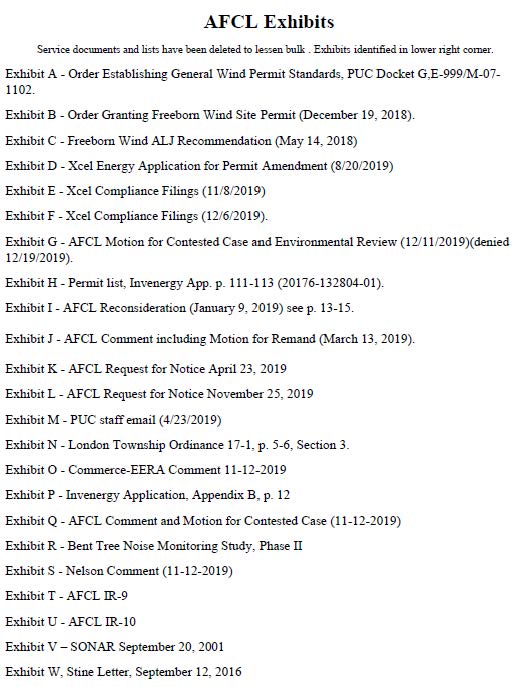
Whew – emailing one per hour takes WAY too long, but even zipped, Exhibit E was still over 100 mb, no way to send that. Posting this took all of 20 minutes with interruptions. Technology…
PPSA Rebuttal time – due 1/28
December 27th, 2019

An odd notice came out today — an extension of the Power Plant Siting Act Annual Hearing comment period, “due to late-filed materials…”
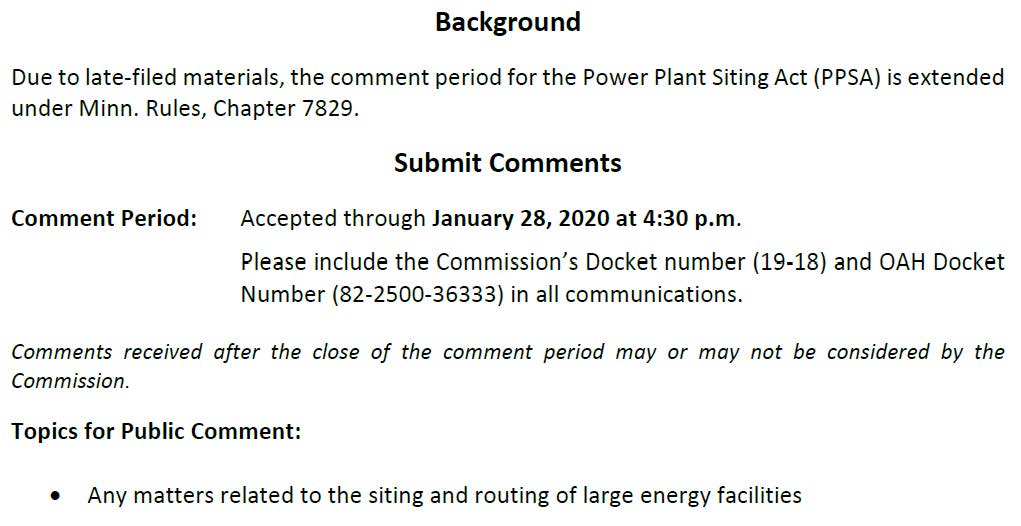
Late filed materials??? Whatever could that be… SNORT!
Naaaah, more likely than not it’s the Comments I’ve filed in all the related wind dockets, plus the PPSA dockets, regarding “ground factor” an inappropriate use of anything but 0.0 as a ground factor:
That’s all about the many wind projects that are improperly using 0.5 and 0.7 ground factor. 0.0 is the only ground factor because the turbine is elevated, and from the source to the “receptor” it is a DIRECT hit! It’s really not hard to understand.

There are so many projects, ALL of the wind projects listed in this year’s Commerce-EERA handout for the PPSA:
These projects were all permitted using bogus noise modeling with GIGO input assumption of 0.5 or even 0.7 for ground factor!!! REALLY! These:

And these:

Guess somebody is wanting time to rebut! May it means we need a contested case, eh?!?! SNORT!
But then, even developer’s expert Mike Hankard agrees that 0.5 is not appropriate for an elevated source like a wind turbine:

It’ll be interesting to see what they have to say.
To look at the PPSA Annual Hearing docket go HERE and enter docket 19-18, using 19 (year number)- 18 (docket number).